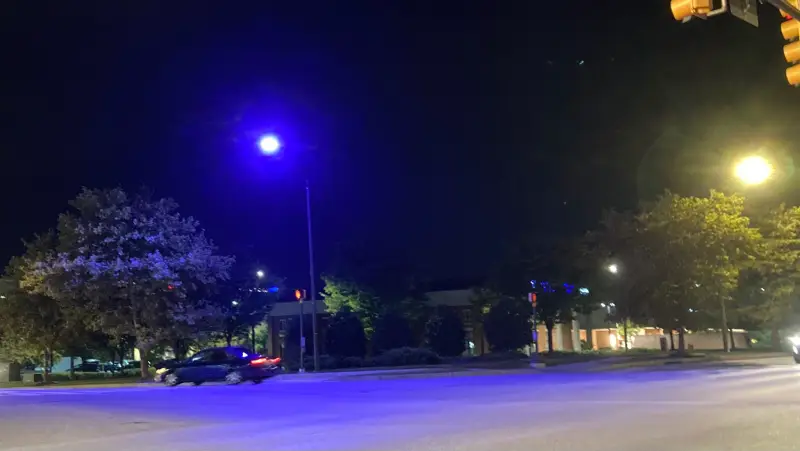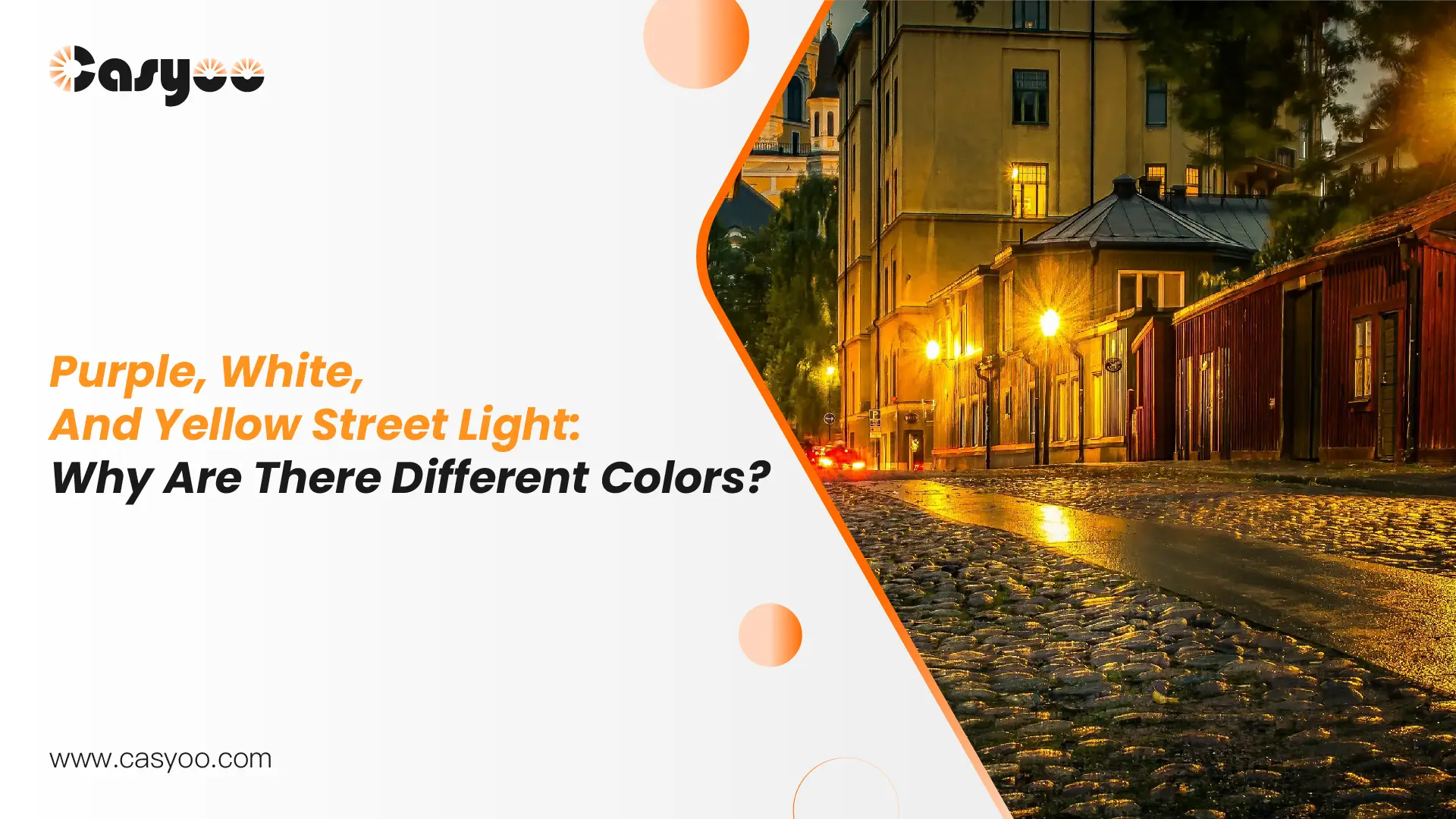For people from different regions, the street lights they see every day may have different colors. In some cities of America, there are purple street lights. In many other countries, yellow street lights light up the night. Recently, a large number of white street lights have replaced the yellow ones. Have you ever wonder why are there purple, white, and yellow street lights?
The varying colors of street lights are typically due to the different light sources used. Yellow street lights are usually high-pressure sodium (HPS) lamps, while purple street lights are often malfunctioning LED lights that rely on phosphor coatings. In contrast, properly functioning LED street lights emit white light. Find the detailed reasons why street lights have different colors in the following passage!
Why are street lights yellow instead of white?
At present, the most commonly used light source for street lights is high-pressure sodium lamps. When HPS street lights are working, sodium vapor is discharged in the arc tube to produce yellow light. Before the invention of LED lights, sodium lamps were the most efficient and energy-saving. The light efficiency of high-pressure sodium lamps is several times that of incandescent lamps, and they can last twenty times longer than incandescent lamps. Besides, their fog permeability is outstanding compared with other light sources. Furthermore, compared with other colors, people are relatively more sensitive to yellow light. Yellow street lights can also help beautify the city night view and make citizens feel more comfortable.

Why are some yellow street lights replaced by white street lights?
In some cities like Rome, many yellow HPS street lights have been replaced by white LED street lights. With the development of LED technology, more and more cities are considering using LED street lights for the following reasons:
1. Energy saving: At present, the luminous efficiency of white LED can reach 110 Im/W, and it can be even higher with further development. With high-efficiency power supplies, high-power LED street lights can be 50% to 60% more energy-saving than HPS lamps. The huge potential of LED street lights in energy saving directly reduces the cost of public lighting projects.
2. Low maintenance cost: Do LED street lights last longer than HPS? Yes. Conventional HPS lamps require replacement on average every year and a half. In contrast, LED lights can last for 5 to 10 years without replacement.
3. High CRI: LED has a high color rendering index (75-80), making the road surface look brighter and keep the drivers alert. High-pressure sodium lamps have a narrow spectrum and low CRI (20-40). So it is difficult to clearly identify pedestrians and vehicles on the road.
4. Environmentally friendly: The production and recycling of LED street lights will not pollute the environment. Besides, they do not produce electromagnetic interference while working. High-pressure sodium lamps contain mercury, argon and other elements, and the electronic ballasts will produce electromagnetic interference.
5. Optional color temperature: LED street lights can be designed with different color temperature to meet the needs of different occasions. They can also achieve the same yellow lighting as sodium lamps.
6. High LPD: LED road lamps not only have high lighting power density (LPD), but also produce no flicker, making them very suitable for road lighting.
Yellow vs. white street lights: which is better?
Yellow street lights, which mostly employ high-pressure sodium (HPS) bulbs, became the standard decades ago because they were inexpensive, efficient, and had great fog penetration. These lamps have inexpensive startup costs, making them a viable option for many communities. Even though LED street lights have many advantages and are more suitable for the world today, the transition to white LED street lights has been slow. This is mostly due to higher upfront costs and the need to replace existing infrastructure.
What is the difference between HPS and LED street lights?
- Nighttime safety: Yellow HPS lamps have less glare, which is safer, but their color rendering is poor. White LEDs improve visibility but might increase glare if not properly regulated.
- Light pollution: White LEDs scatter more light, causing pollution, but yellow LEDs scatter less, making them suitable for residential and natural environments.
- Visual comfort: White LEDs might be harsher, especially at higher color temperatures, but yellow light seems cozier.
- Efficiency: Despite their higher initial price, LEDs save a lot of money over time because they are 50-60% more energy efficient and last longer than HPS lamps.
What color temperature should cities choose?
In metropolitan places where visibility and safety are paramount, white LEDs are frequently the best option. Yellow street lights may still be preferable in rural areas or locations with high fog because they penetrate fog more effectively and reduce glare. According to a study, reducing the CCT of roadways from 5000K to 3000K increases visibility on foggy routes by about 4%. This can help lessen the likelihood of an automobile collision. Cities may reap the benefits of yellow illumination by using adjustable color temperature LED street lights that balance energy economy and the desired yellow impact.
Why are some street lights purple?
Street lights turning purple is closely related to how they work to produce white light.To produce white LED light, LEDs of different colors are combined with various phosphor coatings, which modify the emitted light spectrum. For example, most LED street lights use blue LED and yellow phosphor to emit white light, because blue light has smaller wavelength, higher energy and thus higher efficiency.
However, as time passes, the phosphors of street lights with low quality will be likely to fall off. Reasons for phosphors falling off include prolonged exposure to high temperature and high humidity environments, vibration, etc. When the phosphors fall off, the LED street lights will emit the original blue light, which looks purple because the wavelengths of these two light are similar.

Frequently asked questions about yellow street lights
Q: Why are yellow street lights disappearing?
A: White LED street lighting replaces yellow high-pressure sodium (HPS) technology because LED displays better energy conservation and longer operational time along with improved lighting control. The adoption of LED technology leads to reduced maintenance expenses and light pollution, so it has become the top choice for current street lighting solutions.
Q: Are yellow street lights better for fog?
A: Yes, yellow lights are often considered better for foggy conditions because they have a longer wavelength that scatters less in fog compared to white light. The longer wavelength of yellow lights produces less glare which enhances driver visibility.
Q: Do white LED street lights cause more glare than yellow ones?
A: White LED lights can cause more glare compared to yellow lights due to their higher color temperature and intensity. However, LED lighting developments today include components that minimize glare effects.
To wrap up
Purple street lights are LED street lights that go wrong because the phosphor coating fall off. The government has replaced many of them and use new street lights with better performance. Yellow street lights are HPS street lights, which apply sodium to emit yellow light. This kind of light have high fog permeability and low CRI. Although they are the main type of street lights on the streets, these years many of them have been replaced with white LED street lights with higher efficiency, CRI, and other advantages.




